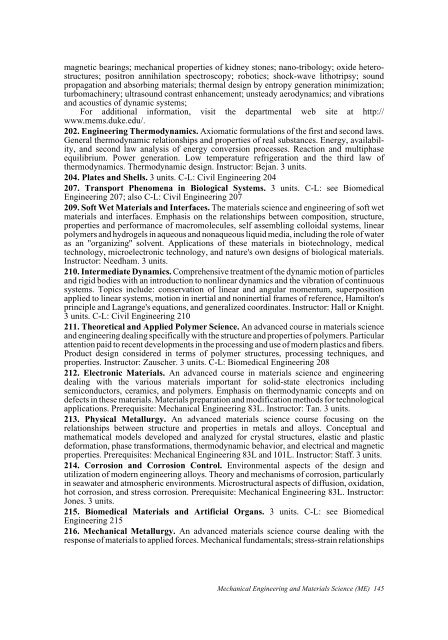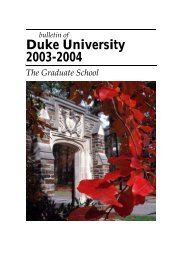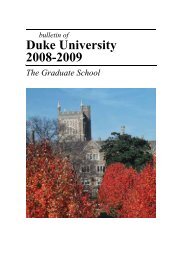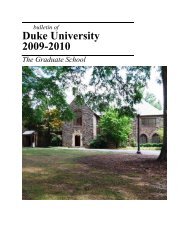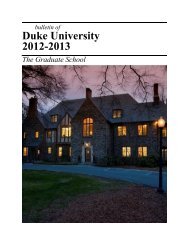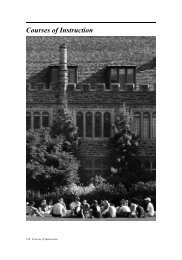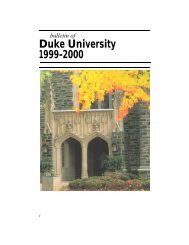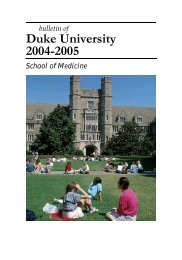2005-06 - Office of the Registrar - Duke University
2005-06 - Office of the Registrar - Duke University
2005-06 - Office of the Registrar - Duke University
You also want an ePaper? Increase the reach of your titles
YUMPU automatically turns print PDFs into web optimized ePapers that Google loves.
magnetic bearings; mechanical properties <strong>of</strong> kidney stones; nano-tribology; oxide heterostructures;<br />
positron annihilation spectroscopy; robotics; shock-wave lithotripsy; sound<br />
propagation and absorbing materials; <strong>the</strong>rmal design by entropy generation minimization;<br />
turbomachinery; ultrasound contrast enhancement; unsteady aerodynamics; and vibrations<br />
and acoustics <strong>of</strong> dynamic systems;<br />
For additional information, visit <strong>the</strong> departmental web site at http://<br />
www.mems.duke.edu/.<br />
202. Engineering Thermodynamics. Axiomatic formulations <strong>of</strong> <strong>the</strong> first and second laws.<br />
General <strong>the</strong>rmodynamic relationships and properties <strong>of</strong> real substances. Energy, availability,<br />
and second law analysis <strong>of</strong> energy conversion processes. Reaction and multiphase<br />
equilibrium. Power generation. Low temperature refrigeration and <strong>the</strong> third law <strong>of</strong><br />
<strong>the</strong>rmodynamics. Thermodynamic design. Instructor: Bejan. 3 units.<br />
204. Plates and Shells. 3 units. C-L: Civil Engineering 204<br />
207. Transport Phenomena in Biological Systems. 3 units. C-L: see Biomedical<br />
Engineering 207; also C-L: Civil Engineering 207<br />
209. S<strong>of</strong>t Wet Materials and Interfaces. The materials science and engineering <strong>of</strong> s<strong>of</strong>t wet<br />
materials and interfaces. Emphasis on <strong>the</strong> relationships between composition, structure,<br />
properties and performance <strong>of</strong> macromolecules, self assembling colloidal systems, linear<br />
polymers and hydrogels in aqueous and nonaqueous liquid media, including <strong>the</strong> role <strong>of</strong> water<br />
as an ''organizing'' solvent. Applications <strong>of</strong> <strong>the</strong>se materials in biotechnology, medical<br />
technology, microelectronic technology, and nature's own designs <strong>of</strong> biological materials.<br />
Instructor: Needham. 3 units.<br />
210. Intermediate Dynamics. Comprehensive treatment <strong>of</strong> <strong>the</strong> dynamic motion <strong>of</strong> particles<br />
and rigid bodies with an introduction to nonlinear dynamics and <strong>the</strong> vibration <strong>of</strong> continuous<br />
systems. Topics include: conservation <strong>of</strong> linear and angular momentum, superposition<br />
applied to linear systems, motion in inertial and noninertial frames <strong>of</strong> reference, Hamilton's<br />
principle and Lagrange's equations, and generalized coordinates. Instructor: Hall or Knight.<br />
3 units. C-L: Civil Engineering 210<br />
211. Theoretical and Applied Polymer Science. An advanced course in materials science<br />
and engineering dealing specifically with <strong>the</strong> structure and properties <strong>of</strong> polymers. Particular<br />
attention paid to recent developments in <strong>the</strong> processing and use <strong>of</strong> modern plastics and fibers.<br />
Product design considered in terms <strong>of</strong> polymer structures, processing techniques, and<br />
properties. Instructor: Zauscher. 3 units. C-L: Biomedical Engineering 208<br />
212. Electronic Materials. An advanced course in materials science and engineering<br />
dealing with <strong>the</strong> various materials important for solid-state electronics including<br />
semiconductors, ceramics, and polymers. Emphasis on <strong>the</strong>rmodynamic concepts and on<br />
defects in <strong>the</strong>se materials. Materials preparation and modification methods for technological<br />
applications. Prerequisite: Mechanical Engineering 83L. Instructor: Tan. 3 units.<br />
213. Physical Metallurgy. An advanced materials science course focusing on <strong>the</strong><br />
relationships between structure and properties in metals and alloys. Conceptual and<br />
ma<strong>the</strong>matical models developed and analyzed for crystal structures, elastic and plastic<br />
deformation, phase transformations, <strong>the</strong>rmodynamic behavior, and electrical and magnetic<br />
properties. Prerequisites: Mechanical Engineering 83L and 101L. Instructor: Staff. 3 units.<br />
214. Corrosion and Corrosion Control. Environmental aspects <strong>of</strong> <strong>the</strong> design and<br />
utilization <strong>of</strong> modern engineering alloys. Theory and mechanisms <strong>of</strong> corrosion, particularly<br />
in seawater and atmospheric environments. Microstructural aspects <strong>of</strong> diffusion, oxidation,<br />
hot corrosion, and stress corrosion. Prerequisite: Mechanical Engineering 83L. Instructor:<br />
Jones. 3 units.<br />
215. Biomedical Materials and Artificial Organs. 3 units. C-L: see Biomedical<br />
Engineering 215<br />
216. Mechanical Metallurgy. An advanced materials science course dealing with <strong>the</strong><br />
response <strong>of</strong> materials to applied forces. Mechanical fundamentals; stress-strain relationships<br />
Mechanical Engineering and Materials Science (ME) 145


